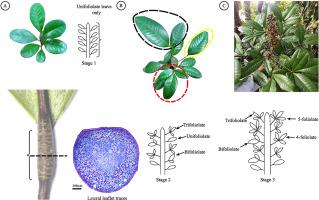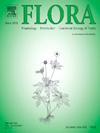Conchocarpus heterophyllus (A.St.-Hil.) Kallunki & Pirani (芸香科)的异形发育:从单小叶叶片看叶的发育过程
IF 1.7
4区 生物学
Q3 ECOLOGY
引用次数: 0
摘要
异叶是某些物种器官发育突然变化的一种现象。在我们对海螺(Conchocarpus heterophyllus)的研究中,我们观察到幼苗、幼株和处于生殖期的植株之间的叶型存在显著差异,这表明植物发育过程中存在过渡事件。本研究的重点是深入研究异叶木犀属植物的这些异叶和异叶事件,为芸香科植物的单小叶状态提供新的证据。研究人员对处于不同发育阶段的成熟叶片进行了形态学和解剖学观察。结果表明,异叶木犀属植物在三个阶段的叶片形态都发生了变化。在第一阶段,幼苗从第一片叶子开始就只长单叶。在子叶的第八至第十节之后,异叶现象开始明显,除了单叶外,还出现了含有 2-3 片小叶的叶片,这是第二阶段的特征。第三阶段是生殖阶段的开始,以花序的出现为标志。在这一阶段,叶片的复杂程度各不相同,小叶的数量从 2 到 5 不等,而且缺少单叶。此外,我们的研究还发现,所有单小叶叶片的叶柄先端肿胀区域都有小叶的维管束痕迹,出现在第 1 和第 2 阶段。这些维管束痕迹被解释为单叶叶片中失去的侧生小叶的残余,是复叶中这种特殊情况的新证据。异叶植物的异叶是一种遗传控制现象,因此,涉及 microRNA(尤其是 microRNA 156 和 172)的前瞻性研究有可能为了解不同阶段之间过渡的遗传机制提供有价值的见解。本文章由计算机程序翻译,如有差异,请以英文原文为准。

Heteroblasty in Conchocarpus heterophyllus (A.St.-Hil.) Kallunki & Pirani (Rutaceae): An approach of leaf development from the unifoliolate leaves
Heteroblasty is a phenomenon marked by abrupt changes in the development of organs of certain species. In our research on Conchocarpus heterophyllus, a shrub with palmately arranged leaflets ranging from 3(4) to 5(–7), we observed significant variations in leaf patterns between seedlings, young plants, and plants in the reproductive phase, indicating transition events during plant development. The focus of this study is to thoroughly investigate these events of heteroblasty and heterophylly in C. heterophyllus, with new evidence of the unifoliolate condition in Rutaceae. Morphological and anatomical observations were conducted from mature leaves of individuals at different stages of development. The results show that the heteroblasty in C. heterophyllus is marked by changes in leaf patterns across three stages. In stage 1, seedlings exclusively produce unifoliolate leaves from the first foliage leaf. After the eighth to tenth node from the cotyledons, heterophylly becomes evident with the emergence of leaves containing 2–3 leaflets, in addition to unifoliolate leaves, characterizing the second stage. The third stage is defined by the onset of the reproductive phase, marked by the presence of inflorescences. In this stage, the leaf complexity varies, with the number of leaflets ranging from 2 to 5, and unifoliolate leaves are lacking. Furthermore, our study identified the occurrence of vascular traces of leaflets in the swollen region located at the apex of the petiole of all unifoliolate leaves, occurring in stages 1 and 2. These vascular traces are interpreted as remnants of the lost lateral leaflets in unifoliolate leaves and represent novel evidence of this special condition in compound leaves. Heteroblasty in C. heterophyllus is a genetically controlled phenomenon, and consequently, prospective investigations involving microRNAs, particularly microRNAs 156 and 172, have the potential to provide valuable insights into the genetic mechanisms underlying the transition between different phases.
求助全文
通过发布文献求助,成功后即可免费获取论文全文。
去求助
来源期刊

Flora
生物-植物科学
CiteScore
3.30
自引率
10.50%
发文量
130
审稿时长
54 days
期刊介绍:
FLORA publishes original contributions and review articles on plant structure (morphology and anatomy), plant distribution (incl. phylogeography) and plant functional ecology (ecophysiology, population ecology and population genetics, organismic interactions, community ecology, ecosystem ecology). Manuscripts (both original and review articles) on a single topic can be compiled in Special Issues, for which suggestions are welcome.
FLORA, the scientific botanical journal with the longest uninterrupted publication sequence (since 1818), considers manuscripts in the above areas which appeal a broad scientific and international readership. Manuscripts focused on floristics and vegetation science will only be considered if they exceed the pure descriptive approach and have relevance for interpreting plant morphology, distribution or ecology. Manuscripts whose content is restricted to purely systematic and nomenclature matters, to geobotanical aspects of only local interest, to pure applications in agri-, horti- or silviculture and pharmacology, and experimental studies dealing exclusively with investigations at the cellular and subcellular level will not be accepted. Manuscripts dealing with comparative and evolutionary aspects of morphology, anatomy and development are welcome.
 求助内容:
求助内容: 应助结果提醒方式:
应助结果提醒方式:


